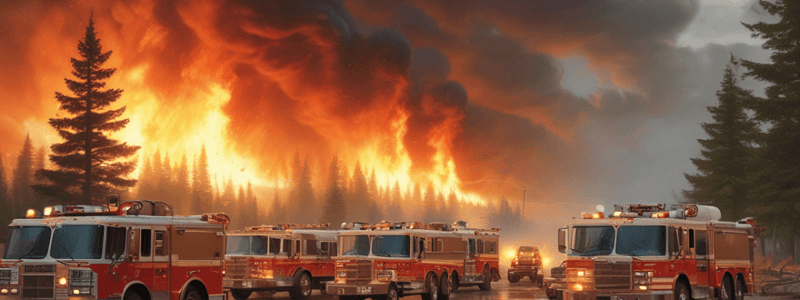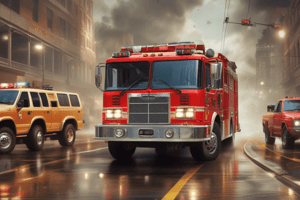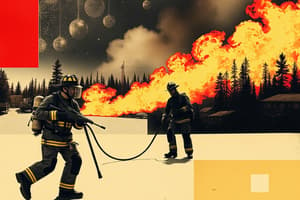Podcast
Questions and Answers
What is a primary advantage of using the Battalion Command Platform during an incident?
What is a primary advantage of using the Battalion Command Platform during an incident?
- It guarantees immediate incident resolution.
- It eliminates the need for paper-based tracking.
- It provides optimal visual coverage and command aides. (correct)
- It requires fewer personnel to manage the incident.
How often should personnel accountability report (PAR) checks be conducted during hazardous operations?
How often should personnel accountability report (PAR) checks be conducted during hazardous operations?
- Only at the start and end of the incident.
- Every 30 minutes.
- Every 20 minutes or less. (correct)
- At least once per hour.
Which of the following is NOT a component of effective command and control during an incident?
Which of the following is NOT a component of effective command and control during an incident?
- Initiating and monitoring incident actions.
- Using social media to update the public. (correct)
- Providing regular updates on the lead tactical talkgroup.
- Tracking crew accountability.
When is it necessary to assign an Incident Scene Safety Officer (ISSO)?
When is it necessary to assign an Incident Scene Safety Officer (ISSO)?
What method should be used to visualize elapsed incident time?
What method should be used to visualize elapsed incident time?
What is the primary focus of developing a command team during an incident?
What is the primary focus of developing a command team during an incident?
What must the first arriving rostered Battalion Chief report with to the incident command post if it is not based in a BCP?
What must the first arriving rostered Battalion Chief report with to the incident command post if it is not based in a BCP?
Which method of managing incident command is recognized by MCFRS in the content?
Which method of managing incident command is recognized by MCFRS in the content?
What format should status updates intended for Command follow?
What format should status updates intended for Command follow?
Who must alert a command officer when personnel find a complex incident upon arrival?
Who must alert a command officer when personnel find a complex incident upon arrival?
When may an EMS Unit Officer act as Incident Commander?
When may an EMS Unit Officer act as Incident Commander?
What must Primary Unit Officers announce during complex events?
What must Primary Unit Officers announce during complex events?
What is a key responsibility of the Incident Scene Safety Officer?
What is a key responsibility of the Incident Scene Safety Officer?
What happens when an EMS Unit Officer establishes Command?
What happens when an EMS Unit Officer establishes Command?
What should be the primary reason for not using the Battalion Command Platform?
What should be the primary reason for not using the Battalion Command Platform?
When should stationary command from the officer seat of fire apparatus be exercised?
When should stationary command from the officer seat of fire apparatus be exercised?
Who is responsible for assigning IMS roles during incident command?
Who is responsible for assigning IMS roles during incident command?
Which of the following is a responsibility of the Incident Scene Safety Officer (ISSO)?
Which of the following is a responsibility of the Incident Scene Safety Officer (ISSO)?
What action can the ISSO take in an imminent life-threatening situation?
What action can the ISSO take in an imminent life-threatening situation?
How should the Incident Commander maintain a reasonable span of control?
How should the Incident Commander maintain a reasonable span of control?
What is the first action required if the ISSO takes action due to safety concerns?
What is the first action required if the ISSO takes action due to safety concerns?
In what scenario is it acceptable to expand the IMS?
In what scenario is it acceptable to expand the IMS?
What is the correct designation for the quadrants of a structure when viewed from the address side?
What is the correct designation for the quadrants of a structure when viewed from the address side?
Which side of a structure is usually designated as Side Alpha?
Which side of a structure is usually designated as Side Alpha?
What designation do exposures that are immediately adjacent to the sides of a structure assume?
What designation do exposures that are immediately adjacent to the sides of a structure assume?
In a multi-story building, which floors are generally considered exposures if a fire occurs?
In a multi-story building, which floors are generally considered exposures if a fire occurs?
How are floors typically numbered in a building, unless otherwise specified?
How are floors typically numbered in a building, unless otherwise specified?
What is meant by the floor designation when referring to the third floor?
What is meant by the floor designation when referring to the third floor?
In multi-family dwellings, what is a commonly used designation for levels that are not directly at the ground entrance?
In multi-family dwellings, what is a commonly used designation for levels that are not directly at the ground entrance?
Which of the following statements about floor designations in incident command is correct?
Which of the following statements about floor designations in incident command is correct?
What distinguishes a terrace level in a structure?
What distinguishes a terrace level in a structure?
In the context of incident response, what is primarily indicated by the hot zone?
In the context of incident response, what is primarily indicated by the hot zone?
What is the purpose of establishing isolation zones during an incident?
What is the purpose of establishing isolation zones during an incident?
Which of the following best describes the warm zone in incident management?
Which of the following best describes the warm zone in incident management?
How should the various levels of a structure be designated according to incident command?
How should the various levels of a structure be designated according to incident command?
When encountering a structure without conventional layouts, what must be communicated to the Command?
When encountering a structure without conventional layouts, what must be communicated to the Command?
What characterizes a cold zone in an incident response operation?
What characterizes a cold zone in an incident response operation?
What role does the Incident Commander play in relation to isolation zones?
What role does the Incident Commander play in relation to isolation zones?
What must the first arriving Primary Unit Officer do first upon arrival at an incident?
What must the first arriving Primary Unit Officer do first upon arrival at an incident?
In stationary command, what is a critical step that must be taken before establishing command?
In stationary command, what is a critical step that must be taken before establishing command?
What geographical designation should the command name typically use?
What geographical designation should the command name typically use?
Which zone is the incident command post established in?
Which zone is the incident command post established in?
What should be done if there is an applicable Standard Operating Procedure (SOP) at an incident?
What should be done if there is an applicable Standard Operating Procedure (SOP) at an incident?
What action should the Incident Commander engage in to maintain command during an incident?
What action should the Incident Commander engage in to maintain command during an incident?
What must be established by the Incident Commander regarding the incident?
What must be established by the Incident Commander regarding the incident?
Which component is critical for the first arriving officer to determine for effective incident management?
Which component is critical for the first arriving officer to determine for effective incident management?
Flashcards are hidden until you start studying
Study Notes
Battalion Command Platform and Incident Command
- The Battalion Command Platform is the ideal location for incident command operations, providing effective oversight.
- It should not be used if superior visibility exists at another site.
- Stationary command from a fire apparatus is allowed, but it is a last-resort option due to limited capabilities.
IMS Components Usage
- Assignment of IMS roles and functions is exclusively the responsibility of the Incident Commander or as per standard procedure.
- The Incident Commander should utilize IMS components only as needed to maintain a manageable span of control.
- Expansion of IMS is necessary to effectively manage complex incidents.
Key IMS Positions
-
Incident Scene Safety Officer (ISSO):
- Monitors safety hazards and ensures personnel safety.
- Does not participate in tactical operations.
- Has the authority to halt actions in life-threatening situations, with immediate reporting to the Incident Commander.
-
First arriving Battalion Chief must bring essential documents and a Mobile Data Computer (MDC) to the incident command post if it’s not at a BCP.
Tactical Operations and Command Function
- Personnel must notify a command officer upon encountering a complex incident.
- Any unit officer can announce command if it benefits the operation.
- An EMS Unit Officer can become Incident Commander if no other officer is present.
- Command must use tactical worksheets for tracking objectives and resources.
Communication and Tracking
- Status updates for command must be formatted using Location-Conditions-Actions-Needs (LCAN).
- Primary Unit Officers should announce the Incident Commander's unit identifier and a clear command name (usually the street name) during complex events.
Methods of Managing Incident Command
- Tactical Command:
- Provides continuous command during incidents and tracks crew accountability.
- Employs an ISSO as required and selects the Battalion Command Platform for optimal visibility and resources.
- Uses methods to monitor actions, track time, and report on incidents effectively.
- Performs regular personnel accountability reports (PAR) checks, not exceeding a 20-minute interval in hazardous areas.
Policy Cancellation
- This policy supersedes previous policies regarding Incident Command and Incident Command Teams dated 2002 and 2016.
Terrace Level Definition
- A terrace level provides primary access to living spaces via an interior common area, with an additional exit at ground level at the rear.
Incident Layout and Command
- In unconventional building layouts, unit officers must inform Command about the structure's design for proper incident management.
- The Incident Commander must clarify the structure's various levels for effective response.
Isolation Zones and Action Circles
- Isolation zones define incident action areas based on hazard levels and are shaped according to the incident characteristics, not always circular.
- Hot Zone: Area with the highest hazard where actions are actively taking place.
- Warm Zone: Transitional area with lesser hazards, separating the hot zone from the cold zone.
- Cold Zone: Free from incident hazards; the command post is located here.
Tactical Command Responsibilities
- Primary Unit Officer must conduct a comprehensive size-up from all angles of the structure.
- Applicable Standard Operating Procedures (SOP) must be utilized if available.
- The Command is typically named after the geographic location, specifically the street name.
- Incident strategy and objectives must be announced as per other response policies.
- Additional resources can be requested as needed, and radio updates are essential for coordination.
Stationary Command Procedure
- The Incident Commander must ensure adherence to Tactical Command procedures before establishing stationary command.
- Situational awareness and incident objectives must be clearly defined.
Structural Designation
- Structures are divided into quadrants (Alpha to Delta), starting from the left front corner when facing the address side.
- The incident commander can designate any structure side as Side Alpha, with others labeled clockwise.
- Exposures are designated based on adjacent structure sides, with multi-story structures considering two floors above and one below as exposures.
Floor Designation
- Floors are designated upward from the ground entrance, with the ground level possibly having a unique designation.
- Each floor is numbered sequentially, with the first floor being the ground entrance unless otherwise designated.
- The term "Division" refers to personnel assigned to that floor rather than the floor's numerical designation itself.
Studying That Suits You
Use AI to generate personalized quizzes and flashcards to suit your learning preferences.



